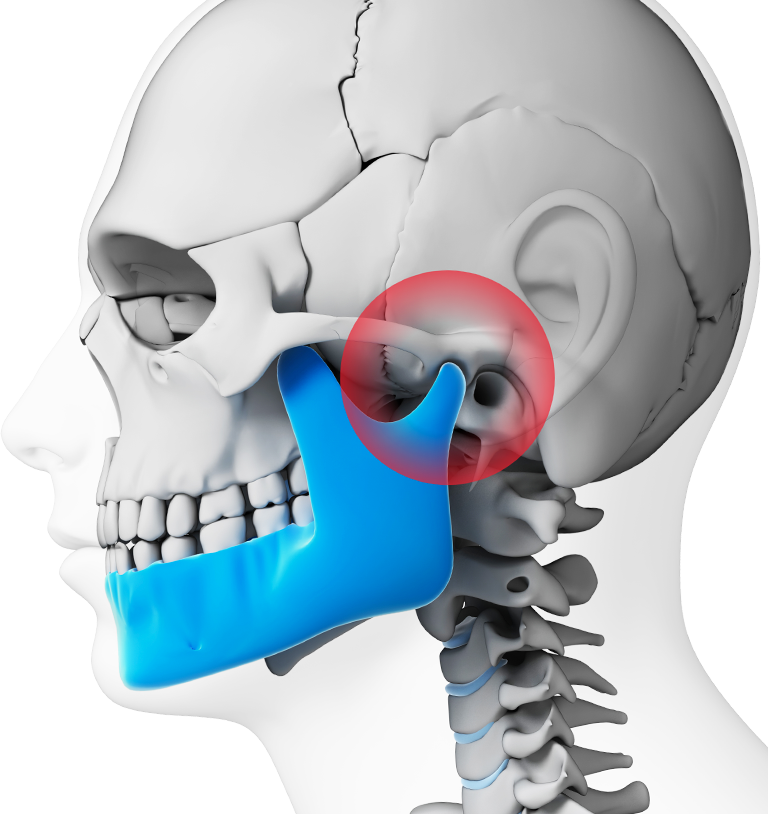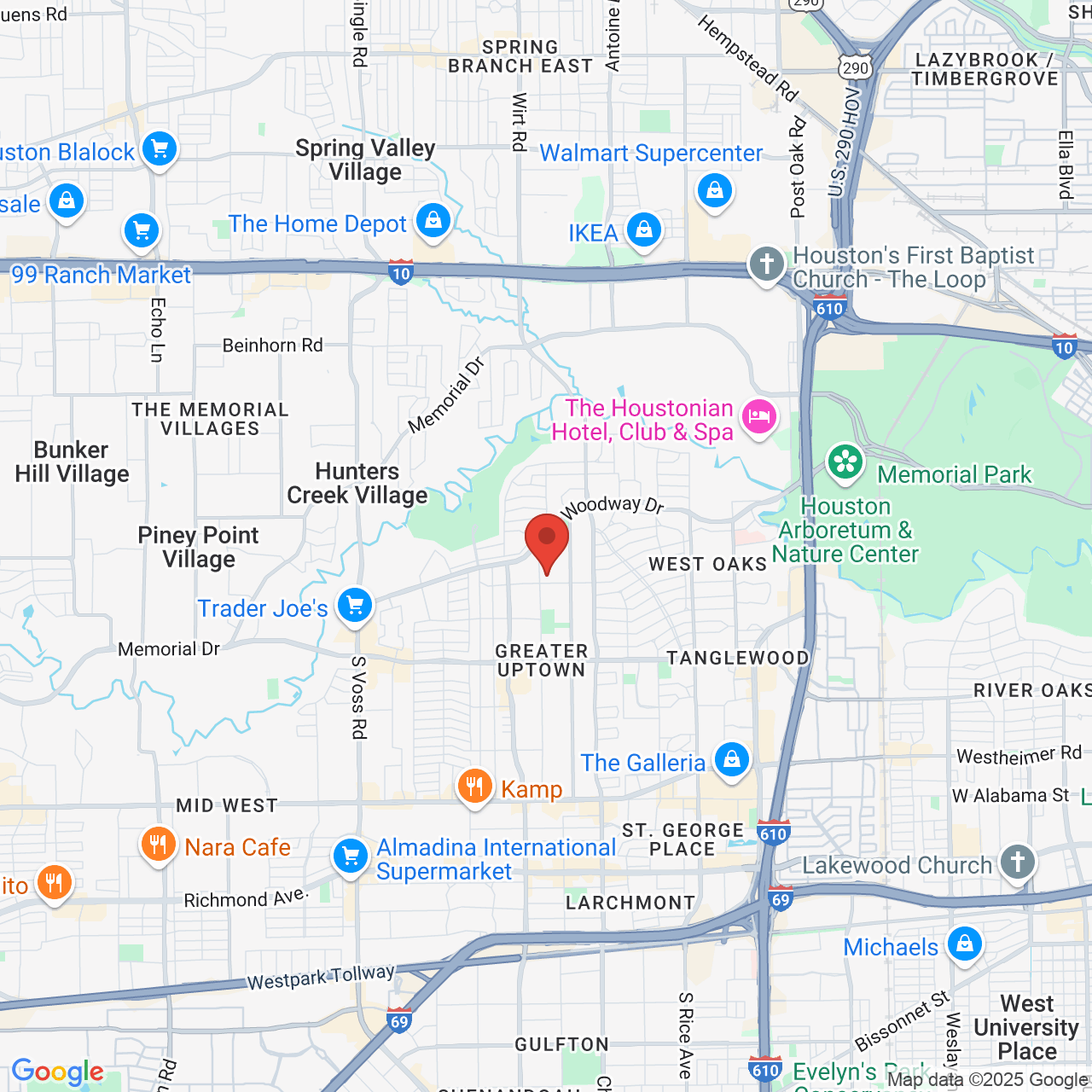
TMJ Treatment
Temporomandibular joint disorder, commonly known as TMJ or TMD, can cause pain and functional issues that negatively affect your daily life.
Dr. Jon Marc Van Slate provides advanced TMJ treatment at his Houston, TX, practice to relieve your symptoms and protect your health.
How can TMJ disorder treatment benefit me?

TMJ Treatment Can:
Alleviate Pain
By properly aligning your bite, treatment can provide relief from painful symptoms, such as headaches, jaw joint pain from clenching, and tension in your neck and shoulders.
Prevent Dental Damage
TMD can create additional pressure on your teeth, which contributes to excessive wear and increases your risk of joint damage, tooth decay, and breakage.
Improve Your Quality of Life
Living with TMJ can impact many aspects of your life with symptoms that affect your mood and health. Treating the condition can allow you to live more fully.Save Money
Treating TMJ disorder early on can reduce expenses throughout your life by minimizing the need for extensive, costly procedures.
Candidates for TMJ Treatment
Temporomandibular Joint Disorder, commonly known as TMJ or TMD, can cause pain and functional issues that negatively affect your daily life. At his Advanced Dental Care of Tanglewood office, Dr. Jon Van Slate has successfully treated hundreds of patients using advanced physiologic TMJ treatment.
People who suffer with TMJ issues are often able to self-diagnose themselves because of frequency of jaw clicking, tenderness in front of the ear and face, and corresponding tension headaches. Some common symptoms of TMJ disease are:
- Clicking, popping, or grating sound when opening or closing your mouth
- Difficulty or discomfort when biting or chewing food
- Frequent tension headaches, or migraines, in the temple area and the back of the head
- Pain and tenderness in front of the ear
- Ear issues, such as constant ringing, stuffiness and pain
- Soreness on the side of the face, especially in the morning
- Jaw pain
- Awareness of clenching and grinding of the teeth
- General muscle pain in the head and neck
- Dizziness and Vertigo
- Sleep breathing issues (snoring and apnea)
- Inability to open your mouth wide, without pain
- Jaws that lock open or closed
- Jaws that shift to the side when opening
TMJ discomfort is a progressive issue that can range from a general nuisance to a debilitating pain that affects a person’s ability to eat and function. A combination of these symptoms may suggest that you are a candidate for TMJ treatment.
The cause of TMJ can have acute or chronic origins. Acute TMJ usually involves trauma, such as a blow to the face or a car accident. Chronic TMJ is very different because is caused by ongoing compression and repositioning of the jaw joints over time. There are five main causes of chronic TMJ: 1) Habitual clenching and grinding 2) Genetic skeletal issues, such as a deep bite, overbite or constricted dental arches 3) Allergies and open mouth breathing habits 4) Arthritis and 5) Chronic posture issues, like forward head posture, that places strain on the head and neck muscles.
Chronic clenching and grinding habits are the most common cause of TMJ symptoms and are often seen with people who have ongoing stress and anxiety issues. Dr. Van Slate believes that the most conservative treatment is always best when treating TMJ. Phase One Treatment involves daytime orthotic and nighttime TM appliances, while Phase Two Treatment involves orthodontics or full mouth rehabilitation.
Botox, narcotics and muscle relaxers are sometimes used in TMJ treatment, but these treatments are not the best for long term resolution of TMJ pain, because they only temporarily alleviate the pain, and do not treat the actual cause of the TMJ issues.
BIOPAK AND JAW TRACKING
Using the computer software that the BIOPAK and K-7 technology provides has led to a tremendous breakthrough in our ability to treat TMJ issues. With these instruments, we can objectively confirm an ideal jaw joint position where the muscles that support the joints are at their resting length and the joint space is fully decompressed. This is important because most TMJ pain comes from fatigued muscles in constant tension as a result of a poor bite position. No joint in the body can thrive under compression because the muscles, tendons, nerves and blood vessels that support the joint are constantly impinged upon.
With the BIOPAK system, we place adhesive leads on your head and neck muscles, much like the leads used for a heart EKG, so that we can visualize exactly where the muscles are at rest. By using a headgear device that sits on top of your head like a hat, we can use jaw tracking software to diagnose joint problems and find the optimal joint position. We take a bite registration at this ideal position which the lab uses to make TMJ appliances and Sleep appliances. This information also confirms the optimal bite position for full mouth rehabilitation procedures.
With this revolutionary technology, there is no more guesswork and nothing arbitrary about where the optimal position of the joint should be.
TENS TRANSCUTANEOUS ELECTRICAL NERVE STIMULATION
An essential tool in finding the ideal bite position is the TENS device. This is used regularly for muscle therapy and muscle rehabilitation. We use TENS for TMJ treatment to achieve a balanced, physiologic jaw position, where the muscles are calm and relaxed. During TENsing, blood flow increases to the muscles and replenishes them with oxygen, while releasing noxious lactic acid. This is very therapeutic and comfortable, especially for people suffering from sore muscles. We can then confirm that the muscles are at rest using the BIOPAK software.
To properly TENS and relax the jaw muscles, adhesive pads are placed adjacent to the jaw joints and neck, so that an ultra-low frequency electric pulse can be emitted to the area.
DEEP TISSUE ULTRASOUND
To relax deeper muscles surrounding the TM joint, we often use an ultrasound device. In this procedure, we place a gel on the tissue that acts as a conductive medium, so the ultrasound can relax deeper muscles. We apply ultrasound to the face, over the joint areas, in a circular motion that is easy and painless.
CBCT CONE BEAM COMPUTED TOMOGRAPHY
CBCT images provide us with several advantages in dentistry. This high definition, three-dimensional image provides us with a better way to diagnose lesions in the head and neck area. Using the CBCT, we can evaluate the sinus and airway for potential issues, and accurately measure bone volume and bone density for implant sites.
CBCT images are also essential for diagnosing and treating TMJ issues. The CBCT gives us a three-dimensional image that is invaluable in evaluating the condition of the jaw joints. We require a CBCT scan prior to any TMJ treatment, to evaluate the size, shape and position of the jaw joints and check for lesions and abnormalities. We also take a CBCT scans during treatment, with the orthotic appliance in place, to confirm that the joint is in a good, decompressed position.
TMJ ORTHOTICS
Traditional methods used to alleviate TMJ symptoms usually involve taking an impression and making an arbitrarily sized bite guard designed to fit over the teeth. Patients are then told to wear the appliance at night. However, this treatment protocol is often not successful in treating TMJ pain because to properly heal compressed jaw joints, they must stay decompressed. This presents a challenge when managing TMJ pain with removable appliances, like bite guards, worn only at night. For this reason, we are now advocating two appliances, a nighttime TM orthotic and a daytime orthotic. We have found that the most predictable way to treat TMJ pain is by keeping the joint decompressed day and night, allowing time for the inflammation to subside and joint healing to occur.
To fabricate the orthotics, we use the Itero digital scanner to fabricate virtual models of the teeth. We then use the BIOPAK and TENS technology to confirm the optimal bite position where the jaw muscles are at rest and the joints are fully decompressed. A bite registration is taken at this ideal physiologic position and used to design the orthotics to mimic this position in the mouth.
A daytime orthotic is much more precise and very different than a conventional bite guard, for the following reasons:
- The thickness of an orthotic is confirmed with the BIOPAK, where the muscles are relaxed, and the joint is decompressed, not at an arbitrary 3mm thickness like conventional bite guards. We make our daytime orthotics on the lower arch, so they can be worn comfortably during the day.
- For comfort, the orthotic allows more room for the tongue, which is especially important for patients with sleep breathing issues, like snoring or sleep apnea.
- Orthotics are anatomical and shaped like teeth, not flat like a conventional bite guard. This allows orthotics to have a repeatable “home base” where the teeth meet in the ideal physiologic position.
- Orthotics are made with a durable, thermoplastic acrylic that can be softened with warm water, for ease of placement.
Orthotics are designed for long term use, so they must be comfortable, durable, hard (never soft), maintain a predictable and repeatable position, cover all the teeth in the arch, have an ideal thickness and designed so they do not impinge on the tongue space.
The nighttime TMJ appliance is designed so that we have ultimate control in keeping the joint decompressed and in the optimal position. Because we sleep in many different positions at night, we have designed the nighttime TMJ orthotic appliance with both an upper and a lower device that has “fins” that work to hold the jaws in the ideal position. Most of our patients with TMJ symptoms love this appliance.
The upper and lower devices are not attached, meaning your jaw will not feel locked together. Since we use the TENS and BIOPAK to confirm the bite position, you will not feel jaw soreness in the morning, like many other sleep appliances. After delivering the orthotics, Dr. Van Slate will make appointments with you to answer questions and make sure your appliances are comfortable.
T-SCAN
Once the orthotic is delivered, we use the T-SCAN to assess and evaluate the occlusion of the appliance. Using the T-SCAN, we can determine if the bite forces and timing of the bite is ideal, with the orthotic in place. We confirm that the bite forces are balanced and do not have interferences that may be detrimental to your bite.
BITE GUARDS
We offer bite guards to patients who show obvious signs of tooth wear and gum recession, but do not have any TMJ symptoms. To be effective, we use a hard, thermoplastic acrylic, that covers all the teeth in the arch. They are designed to be durable and comfortable, for long term use. We advocate wearing them as much as possible, even during the day. We will use the T-SCAN to confirm a balanced bite force.
